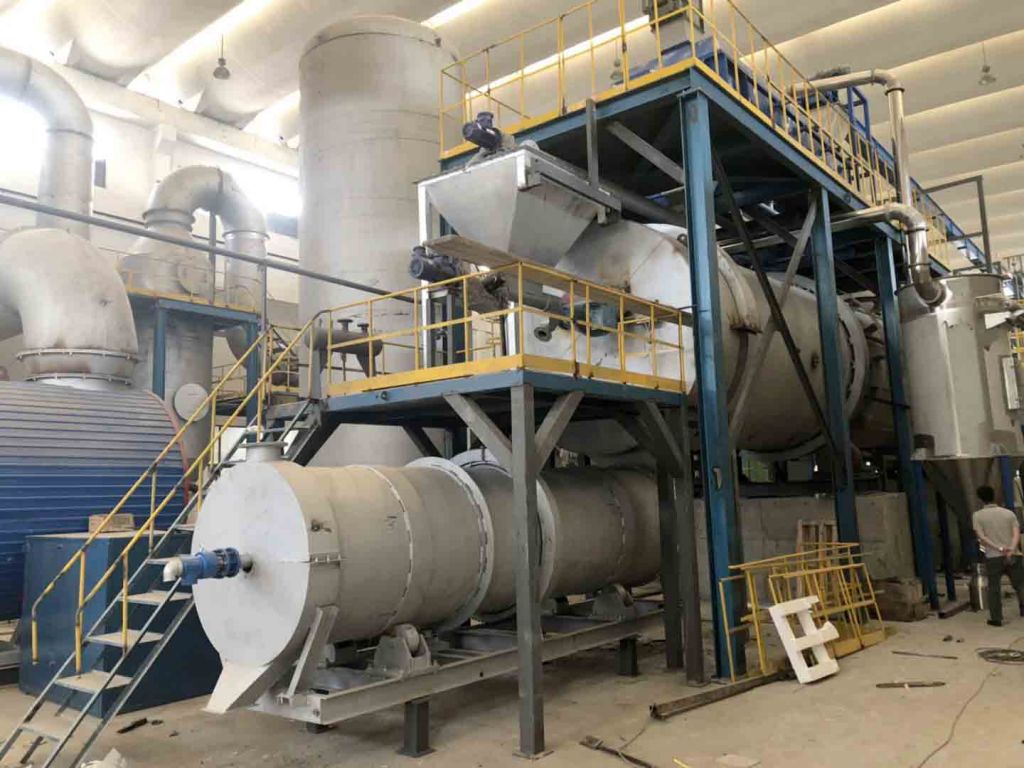Product Description
Low-temperature Rotary Carbonization Furnace
- Operation Principle of Rotary Carbonization Furnace
The furnace carbonizes materials through a destructive distillation
process at a low temperature. In the process, materials are heated
gradually to form maximum amount of fixed carbon in cage structure
though an ordered pyrolysis of plastic mass in them. Graphitization
is prevented by the
low terminal carbonization temperature, which provides the
activating reaction comes next with more C-H chemical bonds
available in carbonized materials.
II. Process of Carbonization Furnace
Retorting gas (volatiles) generated from pyrolysis of materials in
the furnace is injected into the combustor through a tube. and the
high-temperature waste gas generated from the combustion is
injected into the external heating jacket to provide heat required
by carbonization, cutting extra heat demand, saving fuels, and
reducing gas emission.
1)Process of Materials
●Materials are put into feeder bin through feeding inlet, conveyed
into materials channel of carbonization furnace stack by the screw
feeder in feeding bin, and moved towards the discharge outlet
following rotation and gradient of the stack.
●Materials go through pre-drying at **0°C,and then pyrolysis and
pre-carbonization at ******0°C to expel moisture and pyroligneous
liquid before the carbonization at ******0°C.
Temperatures mentioned above are material temperatures. During the
process, materials are carbonized in the furnace by heat radiation
to discharge volatile organic gases before discharged through
output bin.
2) Process of Gas
A mass of volatile gas and liquid are separated out from materials
being heated and carbonized. Volatile gas is induced into
combustion chamber through a tube after flowing reversely with
materials. Temperature of the tube must be above **0°C.
Excess-oxygen combustion of the volatile gas with air supplied
through an air distribution tube releases a large quantity of heat,
and high-temperature waste gas generated thereby is induced into
the heating jacket of carbonization furnace stack through the
specialized tube, providing heat required for materials
carbonization by radiation. Low- temperature gas ejected by the
furnace stack flows into the end gas treatment device through the
heat exchanger and end gas exhausting tube.
Tubes and devices mentioned above must have resistance against
high-temperature and corrosion.
III. Feature of Carbonization Furnace
1) High-temperature waste gas
●At the normal final temperature of carbonization, which is between
******0°C, volatile gas in external thermal carbonization furnace
is inflammable with exposure to oxygen, flame generated thereby
would transmit heat to materials, even ignite them. Temperature of
flames is around **0°C, and temperature of materials could hardly
be controlled below ******0°C as required. Excessively high
temperature would form an ordered graphite crystal structure,
shrink interspaces among microcrystals, and thereby compromise the
pore-forming process.
●The design adopted a material channel with high-temperature waste
gas radiation to avoid flames, which offers an adjustable
temperature of waste gas, a controllable carbonization temperature,
and a higher carbonized material quality for the benefit of
activation process next.
2) Deferred carbonization at low-temperature
●Prolonged duration offers low-temperature pyrolysis with a high
selectivity. Initial pyrolysis breaks weak bonds in material
molecular to generate free radicals which form liquid plastic mass.
The deferred heating process allows such plastic mass to fully
diffuse in materials and react with them. Climbing temperature
urges further pyrolysis of the plastic mass to form a aromatic
nucleus structure with higher stability among coal granules, which
provides sufficient bonds among materials, and thereby reduces
yield of volatiles from pyrolysis for a higher yield of carbonized
materials.
3) Reverse flow of volatile gas and materials
●Heat required for pyrolysis of materials in the channel is
provided by radiation, volatile gas generated thereby flows in the
direction from feeding end to discharging end along with materials
while being heated gradually. The process is free of volatile gas
coagulation and agglomeration. Yet, carbonization temperature in
the furnace is crucial at this point. since a minor deviation would
cause a blockage in the fume channel. Temperature of materials must
be
controlled at a level above **0°C, and temperature of fume channel
above **0°C by a thermocouple sensor.
●Aromatic compound in the volatile gas works as a recarburizer in
the heat condensation stage of carbonization in high-temperature
section of the furnace, unstable chemical bonds in carbons
generated thereby will accelerate the subsequent activation
reaction, and form more pores;
4) Structure of carbonization furnace
●Channel structure of the furnace allows materials to be
distributed evenly (**0° ) in the channel for a larger heating
area, longer heating duration, and thus a more sufficient
absorption of heat.
●Even distribution of materials in the furnace, and the low
stacking height provided by the lifter reduces internal abrasion of
materials, decelerates sliding of materials following rotation of
the furnace stack, and thereby lowers impact force of materials.
Hence, breakage of materials in the softening phase is limited.
5) Special design of lifter blade
●Heat transferred from fume is deferred by the lifter blade mounted
in material channel, which is designed for evenly heating, before
solidified materials are conveyed into high-temperature
section;
●Position of lifter blade shall be determined with consideration of
circular distribution of temperature in the material channel.
Lifter blade in a low-temperature position allows even distribution
of materials on the inner surface of channel, facilitating
sufficient heat absorption and heat transfer efficiency in the
channel.
| Country: |
China |
| Model No: |
Justfine-1003
|
| FOB Price: |
(Negotiable)
Get Latest Price
|
| Place of Origin: |
- |
| Price for Minimum Order: |
- |
| Minimum Order Quantity: |
1 Set |
| Packaging Detail: |
- |
| Delivery Time: |
- |
| Supplying Ability: |
- |
| Payment Type: |
- |
| Product Group : |
- |

